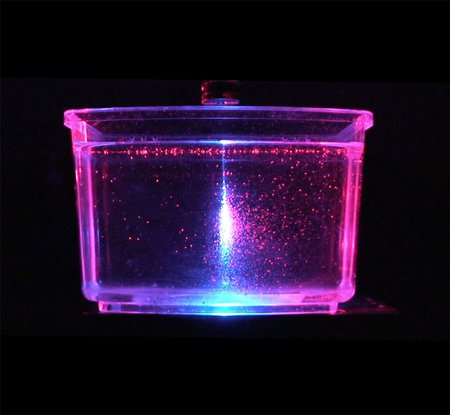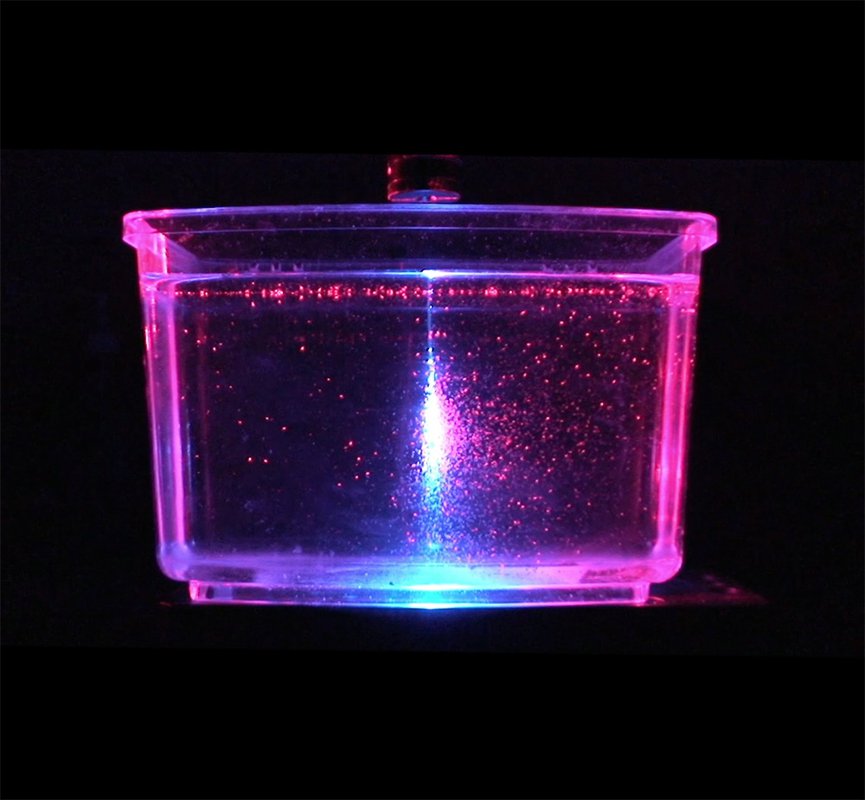Brine shrimp, which are sold as pets known as Sea-Monkeys, are tiny—only about half an inch long each. With about 10 small leaf-like fins that flap about, they look as if they could hardly make waves.
But get billions of similarly tiny organisms together and they can move oceans.
It turns out that the collective swimming motion of Sea-Monkeys and other zooplankton—swimming plankton—can generate enough swirling flow to potentially influence the circulation of water in oceans, according to a new study by Caltech researchers.
The effect could be as strong as those due to the wind and tides, the main factors that are known to drive the up-and-down mixing of oceans, says John Dabiri, professor of aeronautics and bioengineering at Caltech. According to the new analysis by Dabiri and mechanical engineering graduate student Monica Wilhelmus, organisms like brine shrimp, despite their diminutive size, may play a significant role in stirring up nutrients, heat, and salt in the sea—major components of the ocean system.
In 2009, Dabiri's research team studied jellyfish to show that small animals can generate flow in the surrounding water. "Now," Dabiri says, "these new lab experiments show that similar effects can occur in organisms that are much smaller but also more numerous—and therefore potentially more impactful in regions of the ocean important for climate."
The researchers describe their findings in the journal Physics of Fluids.
Brine shrimp (specifically Artemia salina) can be found in toy stores, as part of kits that allow you to raise a colony at home. But in nature, they live in bodies of salty water, such as the Great Salt Lake in Utah. Their behavior is cued by light: at night, they swim toward the surface to munch on photosynthesizing algae while avoiding predators. During the day, they sink back into the dark depths of the water.
A. salina (a species of brine shrimp, commonly known as Sea-Monkeys) begin a vertical migration, stimulated by a vertical blue laser light. |
To study this behavior in the laboratory, Dabiri and Wilhelmus use a combination of blue and green lasers to induce the shrimp to migrate upward inside a big tank of water. The green laser at the top of the tank provides a bright target for the shrimp to swim toward while a blue laser rising along the side of the tank lights up a path to guide them upward.
The tank water is filled with tiny, silver-coated hollow glass spheres 13 microns wide (about one-half of one-thousandth of an inch). By tracking the motion of those spheres with a high-speed camera and a red laser that is invisible to the organisms, the researchers can measure how the shrimp's swimming causes the surrounding water to swirl.
Although researchers had proposed the idea that swimming zooplankton can influence ocean circulation, the effect had never been directly observed, Dabiri says. Past studies could only analyze how individual organisms disturb the water surrounding them.
But thanks to this new laser-guided setup, Dabiri and Wilhelmus have been able to determine that the collective motion of the shrimp creates powerful swirls—stronger than would be produced by simply adding up the effects produced by individual organisms.
Adding up the effect of all of the zooplankton in the ocean—assuming they have a similar influence—could inject as much as a trillion watts of power into the oceans to drive global circulation, Dabiri says. In comparison, the winds and tides contribute a combined two trillion watts.
Using this new experimental setup will enable future studies to better untangle the complex relationships between swimming organisms and ocean currents, Dabiri says. "Coaxing Sea-Monkeys to swim when and where you want them to is even more difficult than it sounds," he adds. "But Monica was undeterred over the course of this project and found a creative solution to a very challenging problem."
The title of the Physics of Fluids paper is "Observations of large-scale fluid transport by laser-guided plankton aggregations." The research was supported by the U.S.-Israel Binational Science Foundation, the Office of Naval Research, and the National Science Foundation.
 A vertical migration of newly hatched A. salina (a species of brine shrimp, commonly known as Sea-Monkeys) is triggered by means of a blue luminescent signal. Animals migrated from the bottom to the top of the tank, following the cue of the blue luminescent signal generated by a vertical blue laser beam. A red laser sheet at the center of the tank illustrates the lack of attraction to this particular light source.
Credit: M. M. Wilhelmus and J. O. Dabiri/Caltech
A vertical migration of newly hatched A. salina (a species of brine shrimp, commonly known as Sea-Monkeys) is triggered by means of a blue luminescent signal. Animals migrated from the bottom to the top of the tank, following the cue of the blue luminescent signal generated by a vertical blue laser beam. A red laser sheet at the center of the tank illustrates the lack of attraction to this particular light source.
Credit: M. M. Wilhelmus and J. O. Dabiri/Caltech
 Based on preliminary tests with newly hatched A. salina, a laboratory apparatus was designed to induce controllable collective vertical motion of A. salina. Here, the multi-laser guidance system is shown in operation during a vertical migration experiment. Individual organisms are visible as motile particles in the region illuminated by the green laser, as they swim vertically following the blue laser beam.
Credit: M. M. Wilhelmus and J. O. Dabiri/Caltech
Based on preliminary tests with newly hatched A. salina, a laboratory apparatus was designed to induce controllable collective vertical motion of A. salina. Here, the multi-laser guidance system is shown in operation during a vertical migration experiment. Individual organisms are visible as motile particles in the region illuminated by the green laser, as they swim vertically following the blue laser beam.
Credit: M. M. Wilhelmus and J. O. Dabiri/Caltech
 The trajectories of the PIV tracers show swirling motion adjacent to the vertical migration region (e.g. blue oval). The size of these flow structures are noticeably larger than the size of a single organism (~5 mm). Individual organisms appear elongated given that this image is the result of overlaying a 30-second sequence of raw PIV images.
Credit: M. M. Wilhelmus and J. O. Dabiri/Caltech
The trajectories of the PIV tracers show swirling motion adjacent to the vertical migration region (e.g. blue oval). The size of these flow structures are noticeably larger than the size of a single organism (~5 mm). Individual organisms appear elongated given that this image is the result of overlaying a 30-second sequence of raw PIV images.
Credit: M. M. Wilhelmus and J. O. Dabiri/Caltech



